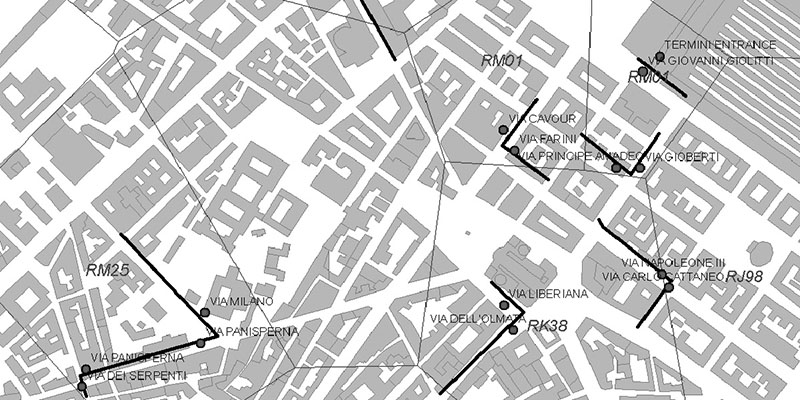Downloads
DOI:
https://doi.org/10.7480/rius.1.199Abstract
In recent years, a new approach for estimating people’s movement in cities has emerged through mobile phone positioning. As opposed to the more traditional methods of traffic surveys, automated counts, or individual counters on streets, the use of aggregated and anonymous cellular network log files has shown promise for large-scale surveys with notably smaller efforts and costs. In addition, a frequent data feed from the cellular network has also been argued to demonstrate fine grain over-time variation in urban movements, which are lacking from the traditional prediction methods. However, despite the positivist approach to the new methodology, additional evidence is needed to show how cellular network signals correlate with the actual presence of vehicles and pedestrians in the city.
The purpose of this paper is to address this shortcoming by presenting the results of a survey effectuated in Rome, Italy in January 2007. Using the results of the two-day experiment, we will employ statistical models to investigate the relationship between empirical pedestrian and traffic counts on the streets of rome with the simultaneous Telecom Italia Mobile (TIM) network signal and traffic prediction. Secondly, we will explore whether the mobile network data demonstrates the significant time-dependent variation that is missing from traditional fixed predictors like space syntax choice and integration analysis and could thus describe cities dynamically over time. Finally, we will also outline some general issues of accuracy in using aggregate mobile network data for estimating people’s movement in cities.
How to Cite
Published
Issue
Section
License
Copyright (c) 2008 Andres Sevtsuk, Carlo Ratti

This work is licensed under a Creative Commons Attribution 4.0 International License.
References
Ahas, R., Aasa, A., Mark, U., Pae, K., Kull, T. (2007) Seasonal tourism spaces in Estonia: case study with mobile positioning data, Tourism Management, 28(3): 898-910.
Anderson S. (ed., 1986), On Streets, MIT Press, Cambridge (Mass.).
Antonini, G., Bierlaire, M. and Weber, M. (2006) Discrete choice models of pedestrian walking behaviour, Transportation Research Part B 40(8): 667-687.
Ben-Akiva, M. et al. (1997) Modeling methods for discrete choice analysis, Marketing Letters, 8:3.
Calabrese, F., Reades, J., Ratti, C. (2007) Eigenplaces: analyzing cities using the space-time structure of the mobile phone network, environment and planning b (submitted).
Cervero, R. (1989) America’s suburban centers: the land use - transportation link, Unwin Hyman, Boston (Mass.).
Chung, J.-S. (2003) Pedestrian environment as urban indicator: developing a GIS model for measuring pedestrian friendliness. MCP Thesis, MIT.
Ellis, C.W. (1986) The spatial structure of streets. In: S. Anderson, ed., On Streets, MIT Press, Cambridge (Mass.).
Handy, S. (1996) Urban Form and Pedestrian choices: study of Austin neighborhoods, Transportation Research Record, 1552, pp. 135-144.
Hillier, B. and Hanson, J. (1984 (1989)) The social logic of space, Cambridge University Press, Cambridge (UK).
Hillier, B., Hanson, J. and Peponis, J. (1987) Syntactic analysis of settlements, Architecture et comportement/Architecture and Behaviour, 3 (3). pp. 217-231.
Mathema, K.B. (2000) Transit useage and urban form: lessons for transit reliant neighborhoods, MIT SMArchS thesis.
Ratti, C., Pulselli, R.M., Williams, S. and Frenchman, D. (2006) Mobile Landscapes: using location data from cell phones for urban analysis, Environment and Planning B: Planning and Design 33, pp. 727-748.
Ratti, C., Sevtsuk, A., Huang, S., Pailer, R. (2005) Mobile landscapes: Graz in real time, Proceedings of the 3rd Symposium on LBS & Telecartography, 28-30 November, Vienna, Austria.
Reades J., Calabrese F., Sevtsuk A., Ratti C. (2007) Cellular census: explorations in urban data collection, IEEE Pervasive Computing.
Rodriguez, D. and Woo, J. (2002) A case study of the relationship between non-motorized travel behaviour and the local physical environment. Paper presented at ACSP conference.
Zegras, C. (2005) Sustainable urban mobility: exploring the role of the built environment. PhD Thesis, MIT.




